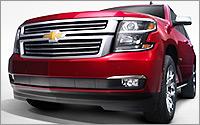automotive
New Chevy Suburban, Tahoe SUVs Debut
- by Karl Greenberg , September 12, 2013
When automakers say a ve hicle is an SUV, they usually mean a unibody (car-like) vehicle that more commonly is called a crossover or CUV.
hicle is an SUV, they usually mean a unibody (car-like) vehicle that more commonly is called a crossover or CUV.
But the CUV abbreviation has been migrating over to SUV
because the vast majority of larger vehicles with a two-box design, a high stance, a lift gate, two rows with lots of storage, or three rows, are actually crossovers.
There's still a solid, consistent market for traditional body-on-frame truck-like SUVs, both mid-size and large. And a lot of the ones out there now have been on the road for over a decade, according to John Schwegman, executive director of Chevrolet and GMC trucks. So the timing is good for Chevrolet's 2015 Suburban and Tahoe truck-based SUVs. Although they launch next year, the automaker revealed them Thursday in New York to the auto press.
advertisement
advertisement
The vehicles are redesigned stem to stern, with a higher-end interior and a brand new, sleeker, contemporary look on the outside. That's an achievement -- as traditional SUVs can't help but look, well, boxy. Schwegman tells Marketing Daily that these and the GMC versions Yukon and Yukon XL, simultaneously revealed in LA, are 75% of the body-on-frame SUV market, competing only with Toyota's Sequoia (which is going away soon), Ford's Expedition and Nissan's Armada. It's an empty-space market.
Maria Rohrer, director of marketing for Chevrolet trucks tells Marketing Daily that the two vehicles are pitched to two entirely different customer groups: the two-row Tahoe is for two-earner families with household income of around $120,000, for whom the vehicle is -- beyond practical considerations -- a reward. "It's an understated symbol of success."
She says the Suburban buyers, however, are likely to be people in the 50's range in single-income families who need the vehicle for carrying kids and equipment. "These people will be using that third row and the greater functionality for storage."
One might think the days of big ladder-frame SUVs ended with the economic ice age in 2008, with sales pulled away by crossovers and sputtering because of gas prices, but the market is strong with the segment up 16% this year, notes Rohrer. She says that while people are looking for fuel efficiency with Tahoe, as it's a more mass-market vehicle (and the automaker says it has achieved higher mileage numbers with engine technology), the Suburban buyer cares less about that, as they are somewhat more affluent and more oriented to practical needs.
The market for these truck-based, ladder-on-frame, muscular SUVs took off like a rocket in the late 90's, when gasoline was cheap and minivans -- a necessary evil -- were the only kid and stuff carriers. The SUV offered an alternative that moms felt were safer and dads regarded as non-emasculating, and a raft of new products boosted sales to 500,000 early in the millennium. That settled down to 250,000 to 300,000 once crossovers came in gasoline prices rose, notes Schwegman. "There really was a 10-year boom from about 1996 to 2006; SUV's reached about 5% of the industry."
He notes that Tahoe really took off early in
the millennium when Chevy offered a four-door version of the truck.
"It was a new alternative," says Schwegman.
There were no crossovers and residuals were great. Since then,
with fuel prices up to $3.50, SUV residuals have normalized and volume is back to the 250,000 to 300,000 range.
Schwegman says that with U.S. oil production way up and demand for Tahoe
and Suburban solid, sales will probably hold steady at least five years out at around 1.6% of the industry, which is better than it sounds at first blush.
"There are 27 auto segments, and
full-size utes are 14th, about even with mid-size pickups, sports cars and vans," he says.
While that's a far cry from the halcyon days of SUV, the transaction prices are huge, higher per
vehicle than a lot of luxury brands, per Schwegman. "Full-size utility transaction prices are north of $47,000 on average; Chevrolet's is $49,000 thousand."
The strongest markets, per
Schwegman, are California, Texas, New York and Florida -- which means marketing can be efficient because it can benefit from a tactical, regional media spend. And it also benefits from longevity of
the nameplate in the market -- it is the longest continuous-use nameplate in the world, a fact that Chevrolet played on at the press conference before the reveal, showing a video of the SUV through
the years, morphing from one version to the next.
"Suburban has been in the market for 80 years, so it's not hard to find customers who have owned multiple models. And there's that pent-up
demand," he says.




